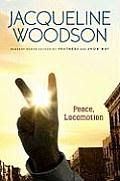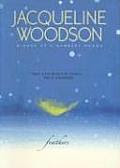 Where the Mountain Meets the Moon
Where the Mountain Meets the Moonby Grace Lin
Little, Brown and Co.
on shelves July 1, 2009
ARC received, compliments of Grace, at the Dublin Literacy Conference
Where the Mountain Meets the Moon is a magical book that explores the power of story. It is about sacrifice, friendship, faith, the transformation of a journey, and the joys of home. More than anything, it is about thankfulness -- about learning that one's fortune does not need to be changed; that fortune is more than gold and jewels.
Minli's mother, Ma, is full of bitterness and discontent about their hard life in the shadow of Fruitless Mountain. Minli's father, Ba, on the other hand, tells stories to easy their hard life. Minli believes in the possibilities of Ba's stories and wants to do what she can to ease Ma's discontent, so she listens to a talking goldfish (just like the ones in Ba's stories) and runs away from home to ask The Old Man of the Moon to change her family's fortune.
Along the way, Minli meets many characters, including a dragon who also has a question for The Old Man of the Moon and who comes along with her. You'll be reminded of The Wizard of Oz, but Minli is no Dorothy -- she is much smarter and more resourceful.
At a crowded market, Minli must find the King. She notices an old beggar man that no one is helping, and she buys him a peach. Experienced fairy tale readers will know at once that she has certainly done the right thing, and probably found the King in disguise.
She has indeed found the King, who helps her by giving her what she's looking for -- a "borrowed line." This "borrowed line" comes in the form of the King's family treasure -- a page "borrowed" from the The Old Man of the Moon's Book of Fortunes that has a line of text that changes depending on the situation. (Thus, the "borrowed line.") The line tells the King, "You only lose what you cling to," and he realizes that, "...by choosing to give you the line, I do not lose it." (p.140)
At the same time that Minli is in the King's walled courtyard getting "the borrowed line" that she needs to present to The Old Man of the Moon, the Dragon is at the city gates making friends with the stone lions. Dragon learns that the city the lions are charged with guarding was once in danger of breaking apart because of political turmoil. The Old Man of the Moon gave them a string to tie around the city if it seemed it would split. The city eventually recovered, but they still had the string, which the Dragon recognizes must be "the borrowed line" that Minli is searching for.
When Minli and the Dragon reunite, they resume their journey to The Old Man of the Moon with not one, but two "borrowed lines!" As they travel into the mountains, Minli is attacked by a Tiger. Dragon saves her, but is seriously injured. Minli races to a nearby mountain village to get help, and the story of how the village came to be there connects back to the city and the King that Minli and the Dragon just left.
You'll have to read the rest on your own to find out how all the stories are masterfully woven together, and how Minli's journey parallels the "journey" of her parents, especially Ma's. You'll have to read it on your own to appreciate the "perfect pitch" of Grace Lin's (fairy tale/fable/ modern/ancient/timeless) voice in this book.
This is a book you'll want to read aloud in grades 3-6, but which is also eminently readable by 3-6th graders. (One of my students, who also got an ARC at the Dublin Literacy conference, read it the Sunday after the conference and made a sign-up sheet for her classmates to borrow it from her -- she didn't get the book back until May, and it had been read by at least a dozen other 4th graders!) This book will also be great for Grand Discussions, Literature Circles, and partner reading.
Keep your eye on this one -- it's a real pearl of a story!


















